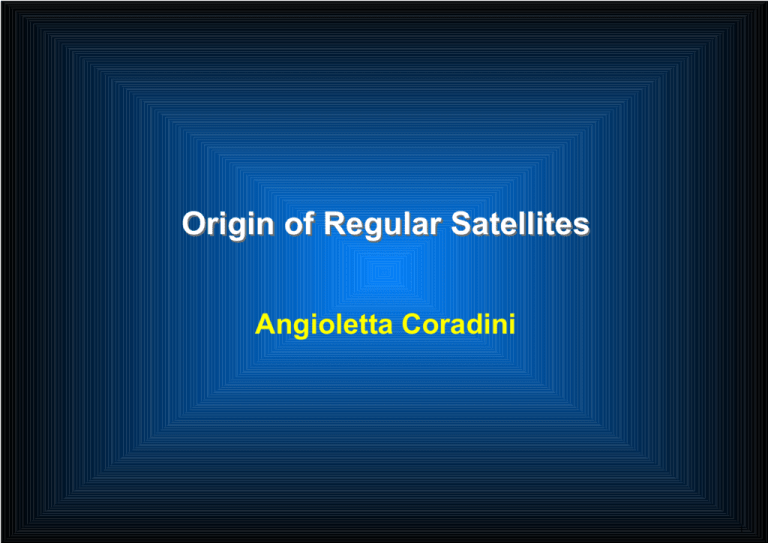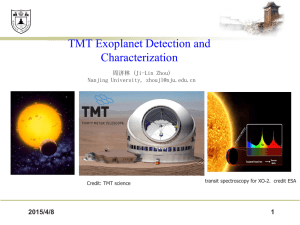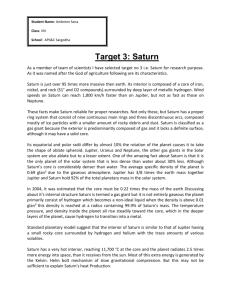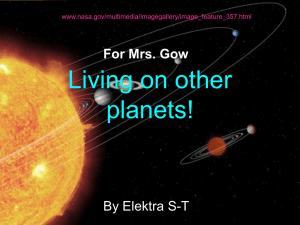Freelance Graphics
advertisement

Origin of Regular Satellites Angioletta Coradini 1 Outline What are the characteristics of satellites to be considered to formulate a theory A brief review of the existing models A description of a 3 D hydrodynamical model in the framework of nucleated instability 2 What Kind of bodies we are studying? Regular Satellites Jupiter has 4 large (>1500 km) moons, Saturn 1, and Uranus and Neptune none. Neptune appears to be moon-poor in general. All are synchronous, except Hyperion (chaotic) Densities are all close to 1 g/cm3, suggesting mainly volatile ices. Uranian satellites are denser than Saturnian ones Uranus satellite densities increase (roughly) with distance. Several of the periods are close to (or actually in) resonance e.g. Mimas-Tethys, Iapetus-Titan. May have had significant effects earlier in history. Uranian system has no resonances (at present day) Irregular Satellites Possibly captured 3 Volcanism, Oceans, Magnetic Fields were discovered on different satellites 4 Enceladus by VIMS Hyperion Titan Phoebe Titan Iapetus by CIRS Iapetus by CIRS 5 The kind of observations Imaging Overall geological/geophysical history Large Scale processes characterizing the surface Figure Spectroscopy Composition Mineralogy Gas emission Theor interaction with ionized particles Magnetometer/Plasma analyzers Internal and external magnetic fields Radio Science Internal structure 6 What satellites tell? Ice becomes a new important component of the satellites in Jupiter system and is dominating the Saturn System There may have been initial variations in composition and structure due to lateral nebular gradients New heating mechanism are dominating these satellites High volatility materials can reduce the ice melting point Enceladus However the quantity and quality of radiogenic element shall be carefully assumed Organic chemistry have surely played an important role How this information can be used in a general scheme of formation? 7 Origin Satellite formation can be a natural byproduct of planet formation. Two formation mechanisms are believed responsible for the majority of the large planetary satellites: Co-formation The Galilean satellites are a key example of a satellite system that is believed to have co-formed with its parent planet, with satellites accumulating within a circumplanetary accretion disk that existed during the final stages of the planets own growth. Impact Our own Moon is thought to have resulted from what was perhaps the largest impact of Earths accretion, and the giant impact hypothesis is favored because could explain dynamical and physical attributes of the Earth-Moon system. Co-existence of both Mechanisms Saturn System could have been affected by intense bombarding but at least Titan origin shold be linked to Saturn formation 8 Working Hypothesis: Co-formation We consider a scenario in which the regular satellites form within circumplanetary accretion disks produced during the final stages of gas accretion (e.g.,Coradini et al1981, Magni and Coradini, 2003, Lubow et al. 1999; D'Angelo et al. 2002, Canup and Ward, 2002)). For a given inflow rate M of gas and solids, a quasi steady-state circumplanetary gas disk is produced through a balance of the inflow supply and the disk's internal viscous evolution, assuming that the disk viscous spreading time is short compared to the timescale over which the inflow changes. Minimum mass subnebulae for the Jupiter and Saturn satellite systems (from Pollack & Consolmagno 1984). 9 Satellite -disk models The -disk (Coradini et al. 1989) assumes viscous evolution of an accretion disk formed via nebula mass inflow into circum-jovian orbit. The steady-state disk conditions were using the Lynden-Bell & Pringle (1974) formalism. The disk was conceived to be highly convective with a strong turbulence viscosity parameter =0.1 in the inner satellite region, and a mass accretion rate of 0.1 solar masses per year New models have been recently proposed that try to remueve this difficulty by carefully evaluation mass accretion rate and viscosity (Mousis et al. 2002a,b; Mousis & Gautier 2003, Makalkin et al. 1999, Makalkin et al. 2006 ). Basic difficulties: difficulties the disk is too hot, accretion too fast, satellite lifetimes against decay in short time due to friction with the gas 10 Alternative model: Slow-inflow accretion disk Canup and Ward 2002 Gas & solids delivered during final stages of Jovian accretion ~10-2 MJ is minimum mass that was processed through satellite disk, but not necessarily in disk all at one time Gas maintains quasi steady-state; solids accrete and buildup in disk with time Result: prolonged satellite formation over >105 years in a cool, gas-starved disk Consistent with incompletely differentiated Callisto, icy outer satellites, satellite survival against viscous decay Regular satellites of giants formed during final slow accretion of gas and solids to planets Inward orbital migration of large satellites likely Differences in final satellites systems can result from similar conditions, depending of stopping inflow 11 Some key open issues for the Canup and Ward 2002 Model 1) Character of late inflow onto Jupiter/Saturn? Flow dynamics within Hill sphere Specific angular momentum on inflow Dust/Ice Ratio unknown 2) Disk viscosity: magnitude & character? Turbulence due to inflow (e.g., Cassen & Moosman) General turbulence associated with Keplerian disks (e.g., Klahr & Bodenheimer) 12 Hydro-dynamical model The planet accretion has been treated assuming an annular region to mimic the planet feeding zone. This region is centered on the Sun and has a thickness comparable with the height of the protosolar nebula at the same distance. In the case treated here, at the Jupiter distance, the annular region has a thickness of about 10 a.u. and at the Saturn distance of about 15 a.u. The reference system is rigidly rotating with an angular velocity equal to the Keplerian one. 13 A new model In the equation of hydrodynamics the viscosity term has been included . The viscosity tensor has been evaluated as a perturbative term following Landau and Lifchitz, approach. The thermal evolution of the disk has been improved We are now able to follow the thermal evolution of the disk due to radiative losses, since the time dependent radiation equation has been solved. 14 The central cell we have introduced quasi-stationary equilibrium structure for the central body and in each time step we have verified if the gas accretion rate is compatible with the assumption that the central body is in hydrodynamic equilibrium. YES Gas can freely enter in the Central cell NO Structure is relaxed 15 The grids 91*91*17 and 121*121*19 (140777 e 278179 mesh points) 16 The effect of turbulent viscosity (1) Saturn accretion: influence of turbulent viscosity 100 Mesh 1 M(SN) = 0.016 M(Sun) Mass of the growing planet (earth masses) 90 r(accr) = 9.54 AU 80 alfa=0 70 alfa=0.1 60 50 40 30 20 10 0 200 400 600 800 1000 1200 time (years) 1400 1600 1800 2000 The accretion time scale of Saturn increase due to the extra pressure related to the turbulence effects: this shall be considered as a timescale, since in this calculation we are not yet considering the effect of the gap. 17 The effect of turbulent viscosity(2) Radius of the disk orbiting Saturn when viscosity is present ( blue ) is smaller then the one inviscid ( black). This is due to the dissipative effects characterizing the turbulent fluid. 18 Jupiter and Saturn disks 10.00 5.00 0.00 -5.00 -10.00 -10.00 -8.00 -6.00 -4.00 -2.00 0.00 2.00 4.00 6.00 8.00 10.00 -10.00 -5.00 0.00 5.00 10.00 19 Surface density in the central plane of SN at the end of the accretion ( exploded view) JUPITER final disk log sigma (gr/cm**2) final SATURN DISK - log sigma (gr/cm**2) 5.70 10.00 5.60 9.90 5.50 9.80 5.40 9.70 5.30 Y (AU) Y (AU) 9.60 9.50 5.20 5.10 9.40 5.00 9.30 4.90 9.20 4.80 9.10 -0.50 -0.40 -0.30 -0.20 -0.10 0.00 X (AU) 0.10 0.20 0.30 0.40 0.50 4.70 -0.50 -0.40 -0.30 -0.20 -0.10 0.00 0.10 0.20 0.30 0.40 0.50 X (AU) 20 Area where the gas has prograde motion Accretion disk JUPITER final disk Vrot/Vkep (prograde region) final SATURN disk - vrot/vkep (prograde region) 5.70 10.00 5.60 9.90 5.50 9.80 5.40 9.70 Y (AU) 5.30 9.60 5.20 9.50 5.10 9.40 5.00 9.30 4.90 9.20 4.80 4.70 -0.50 9.10 -0.40 -0.30 -0.20 -0.10 0.00 X (AU) 0.10 0.20 0.30 0.40 0.50 -0.50 -0.40 -0.30 -0.20 -0.10 0.00 0.10 0.20 0.30 0.40 0.50 21 4 2 JF4 JF2 log <Rd(Kepl)>/R(Jup) 0 JF1 -2 -4 -6 -8 -10 0.5 1 1.5 2 2.5 3 3.5 log r/R(Jup) The region that we can call disk is deeply imbedded in the feeding zone and much smaller than the Hill sphere. Moreover is characterized by the fact that the gas motion from being prograde becomes retrograde in the planet reference system. In Figure are depicted the regions where the gas is in Keplerian motion 22 Jupiter and it surrounding nebula evolution 23 Temperature profiles: Jupiter 5 M(SN)=0.01 M(Sun) 4.5 4 convective 3.5 log T (K) The planet is characterized by the presence of a large inner convective zone divided by a radiative region from the external convecting layer. 3 radiative 2.5 2 convective Mp=0.3 M(Jup) 1.5 Mp=0.1 M(Jup) 1 0 100 200 300 400 500 600 700 r/R(Jup) The two profiles correspond to the p lanet s m asses 0.1and 0.3 Ju piter masses. The external envelope of the planet covers a very large region of more than 700 RJ 24 2 1.8 log Rp/R(Jup) 1.6 Ca 1.4 1.2 Ga 1 Eu 0.8 0.6 Io 4 4.5 5 5.5 6 6.5 7 log Accretion timescale (yr) During the slow contraction phase the planet recedes from the region where presently satellite are located. The formation region of Callisto is in 100.000 years emptied, but 10 millions of years aren t sufficient to clear up the formation region of Io. The planet luminosity evolves from values ranging from about 1.1 10-6 1.1 10-5 -after 10.000 years of evolution to about 1.1 10-6 after about 107 . 25 2.6 2.4 <R(keplerian region)> 2.2 2 log R/R(Jup) 1.8 Radius!!! 1.6 R(protoplanet) 1.4 Ca 1.2 Ga 1 Eu 0.8 0.6 Io 4 4.5 5 5.5 6 6.5 7 log Accretion timescale (yr) Protoplanet radius and external radius of the protosatellitary disk versus accretion timescale for the growing planet in its final evolution phases. At right are plotted the distances of the Galilean satellites 26 1 0 Io Europa Ganymede Callisto log Psat(H2O)/P(r=Rp) -1 -2 -3 -4 -5 -6 0.6 0.8 1 1.2 1.4 1.6 1.8 2 log Rp/R(Jup) Only at Callisto distance ice is always present 27 Saturn and its surrounding nebula evolution 28 Saturn System: Accretion 4 accretion time time (yr) Here is shown the accretion time as function of the mass present in the feeding zone. Obviously the smaller the mass in the feeding zone the longer the accretion time. Saturn reaches a value of 90% of its mass 4 in about 10 y Here the presence of the gap has been considered 10 3 10 final accretion timescale 2 10 0 10 1 10 M(feed.zone)/M(Saturn) 2 10 29 Effective radius of the envelpe 1200 0.0272 1000 Hill lobe limit 0.0133 R(protoplanet)/R(Saturn) The effective radius of the envelope upper part compared with the radius of the core. However it should be taken into account that the envelope, at least at the beginning of the accretion fill the Hill lobe. The material is also rapidly accreted The central part increases in mass and density and gradually becomes separated from the envelope. However for a large part of the initial history core and envelope can be hardly distinguished. Also the boundary with the PSN isn t sharp and frequent mass exchange between the nebula and the envelope are present. Also a kind of disk is formed. The planet assumes its identity only in the final phases, when the accretion is very slow and the gas amount in the PSN decreases. 0.0067 800 M(SN)/M(Sun)=0.0035 600 400 200 140777 mesh points 0 0 1000 2000 3000 time (yr) 4000 5000 6000 30 S aturn acc retion 4 m es h 91*91*15 Rp/R(Saturn), Rd/R(Saturn), Md/M(Titan) 10 R (final prot oplanet) 3 10 R(final ac c r. disk ) 2 10 1 10 0 10 M(final ac c r. dis k ) -1 10 -2 10 3 3. 5 4 4.5 5 5.5 log ac c retion times c ale (y r) 6 6.5 7 The time evolution of the mass of the accretion disk gives us a constraint on the timing of the formation of the regular satellites 31 Angular Momentum at the end of the accretion 18 10 Saturn accretion M(SN)=0.019 M(Sun) core+envelope 17 planet+rec.disk 16 10 central cell 18 10 15 10 core+envelope planet+rec.disk 14 10 13 10 12 10 278179 mesh points blue: turbulent SN alfa=0.003 black: nonturbulent SN 11 10 0 200 400 600 800 time (yr) 1000 1200 1400 specific angular momentum (cm**2/s) specific angular momentum (cm**2/s) 10 3 central cell 16 2 3,2 10 1 1 14 1 alfa=0.1 2 alfa=0.01 3 alfa=0.0 10 12 Jupiter accretion M(SN)=0.017 M(Sun) 10 278179 mesh points 10 10 0 500 1000 1500 time (yr) 32 Saturn accretion: orbital migration of the growing planet 7 decay timescale (years) 10 6 10 tidal interaction with SN radial momentum capture 5 10 angular momentum capture 4 10 0 200 400 600 800 1000 time (years) 1200 1400 1600 1800 33 2 10 1 Mass and temperature of the final disk 0 10 -1 10 -2 10 -3 10 Saturn accretion: M(SN)=0.02 M(Sun) Mp=M(Saturn) 2.5 averaged values -4 10 3 3.5 4 4.5 5 5.5 6 6.5 log accretion timescale (years) 7 7.5 8 2.4 2.3 log Tdisk (K) convolute disk mass (Titan masses) 10 2.2 2.1 2 1.9 1.8 1.6 1.8 2 2.2 2.4 log r/R(Saturn) 2.6 2.8 3 34 Saturn formation: M(SN) = 0.016 M(Sun) 600 Saturn accretion: M(SN)=0.02 M(Sun) Mp=M(Saturn) 2.5 D(centr.cell)=0.02 AU averaged values 550 2.4 450 2.3 central cell log Tdisk (K) 400 350 300 250 200 2.2 2.1 2 150 growing planet photosphere 100 0 500 1.9 1000 1500 time (years) 1.8 1.6 1.8 2 Saturn accretion: M(SN)=0.02 M(Sun) Mp=M(Saturn) 1 2.2 2.4 log r/R(Saturn) 2.6 2.8 3 0 -1 log Psat(H20)/P effective temperature (K) 500 -2 -3 -4 averaged values -5 1.6 1.7 1.8 1.9 2 2.1 log r/R(Saturn) 2.2 2.3 2.4 2.5 35 10.5 Small Particles have shorter decay time than accreted particles Protoplanet boundary 10 log Mcrit(particle) (gr) Ca Ga 9.5 Eu Decay Time 104 years Critical decay time: 10**4 yr 9 4.5 5 5.5 6 6.5 7 log accretion time (yr) 13.5 In the disk accreted particles can survive to the viscous drift and to the disk dissipation! Protoplanet boundary 13 log Mcrit(particle) (gr) Ca Ga 12.5 Eu Critical decay time: 10**6 yr 12 4.5 5 5.5 6 6.5 7 Decay Time 106 years log accretion time (yr) 36 Conclusions 3-D hydrodynamical models reconcile the -disk and the starved disk approach The thermodynamical condition of the evolving disk in which satellite started their formation changed. The dust survives most of these changes, evolves gradually and accumulate in time. Chemistry of the different satellites should reflect these complex processes . 37 This document was created with Win2PDF available at http://www.win2pdf.com. The unregistered version of Win2PDF is for evaluation or non-commercial use only.









